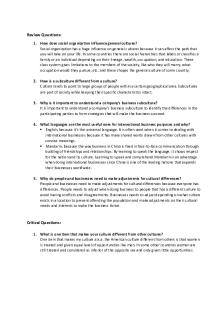Chaptt 6- Review Questions PDF

| Title | Chaptt 6- Review Questions |
|---|---|
| Author | Rhiamae Legaspi |
| Course | Violent Weather/Climate Hazards |
| Institution | California State University Fresno |
| Pages | 2 |
| File Size | 100.6 KB |
| File Type | |
| Total Downloads | 104 |
| Total Views | 145 |
Summary
Chapter 6 Study Guide that I filled out myself, contains practice questions that prepared me for the exams....
Description
Review Questions: Chapter 6: Precipitation Extremes (Floods and Droughts) True/False Exam Questions 1. The onset and termination of droughts are not easily recognized. 2. Tree-ring studies (dendrochronology) have been used to study drought frequencies of occurrence in the U.S. 3. Floods and droughts occur in all continents except Antarctica. 4. The foot of mountains is one of the rainiest places in the world. 5. Slowly-moving cold fronts, dam breaks and tsunamis can cause flash floods. 6. .Cloud seeding using silver iodide works well in warm clouds composed entirely of water droplets. 7. .Rain which falls from a cloud, but evaporates before reaching the ground is called virga. 8. There is no universal definition for drought. The following factors affect floods. Choose A for weather-related factors and B for non-weatherrelated factors. 9. effects of ice jams from previous snowfalls 10. the number of rain events that occur in that same region 11. effects of channelization, land use, dikes, levees, and dams on drainages 12. the magnitudes of snowfalls in the region 13. dumping of trash into arroyos 14. topography along the drainage 15. deforestation Classify the following statements as referring to either agricultural drought, hydrological drought, meteorological/climatological drought, or socioeconomic drought (NOTE: If the duration mentioned is less than one month, the statement relates to agricultural drought. It is meteorological or climatological drought if the duration is either a one season, whole year or longer. Hydrological drought has to do with stream flow, river and lake levels. Socioeconomic drought relates to supply and demand of commodities.) 16. The vessels for transporting goods are grounded due to fallen river levels. 17. Fifteen consecutive days, none of which received as much as 0.25 mm of rainfall. 18. Chicken is in short supply and expensive in the market due to shortage of poultry feeds. 19. Water taps at Porterville, California became dry due to fallen groundwater levels. 20. “15 days, none of which received as much as 0.25 mm of rainfall.” 21. “when annual rainfall is less than 180 mm.” Multiple-Choice questions: Choose the letter of the best answer in each case. 22. Droughts are always accompanied by A. low pressures B. C. cold waves D. warm fronts 23. Which natural hazard causes the highest number of deaths worldwide? A. drought C. earthquake E. volcanic eruption B. D. lightning
24. Which index is used to define drought severity? A. C. Dow Jones index B. lifted index D. index finger
E. refractive index
25. Which flood-producing meteorological phenomenon produces floods along the northern portion of the U.S. West Coast? A. monsoon rainfall C. B. Hawaiian Fire Hose D. Mel-Yu front 26. Which flood-producing meteorological phenomenon produces floods on the Yangtze River in China? A. North American monsoon rainfall C. tropical cyclones (hurricanes) B. Hawaiian Fire Hose D. 27. Which flood-producing meteorological phenomenon produces floods in India, U.S. Southwest, and West Africa? A. C. middle-latitude cyclones B. Hawaiian Fire Hose D. Mel-Yu front 28. Which of the following assertions about people’s response to flood warnings is most true? A. The credibility attached to a warning is related to one’s ability to confirm it. Most people will try to confirm a warning for a time before acting on it, especially after early warning messages. B. The more warning messages received by an individual, the fewer attempts the individual will make at confirmation. C. Messages from friends and relatives are more likely to produce protective behavior than are those from mass media. D. A family is more likely than an individual to take action. E. 29. The term “leisurely disaster” refers specifically to:
a. b. c. d. e.
Flash flood Widespread flood Megadrought The Dust Bowl
30. Radar gathers information about precipitation in clouds by measuring the: A. energy emitted by the precipitation particles. B. absorption characteristics of falling precipitation. C. D. amount of sunlight scattered off the precipitation. E. amount of solar energy passing through the cloud....
Similar Free PDFs

Chaptt 6- Review Questions
- 2 Pages

Chapter 6 Review Questions
- 10 Pages

Chapter 6 Review Questions
- 5 Pages

chapter 6 review questions
- 28 Pages

Chapter 6 Review Questions
- 4 Pages

BLAW 2080 - Ch.6 Review Questions
- 10 Pages

Review Questions
- 6 Pages

Review questions
- 2 Pages

Lesson 6-10 Review
- 26 Pages

Summary - Chapter 6 review
- 1 Pages

Chapter 6 assessment review
- 17 Pages

Chapter 6 Review Guide
- 5 Pages
Popular Institutions
- Tinajero National High School - Annex
- Politeknik Caltex Riau
- Yokohama City University
- SGT University
- University of Al-Qadisiyah
- Divine Word College of Vigan
- Techniek College Rotterdam
- Universidade de Santiago
- Universiti Teknologi MARA Cawangan Johor Kampus Pasir Gudang
- Poltekkes Kemenkes Yogyakarta
- Baguio City National High School
- Colegio san marcos
- preparatoria uno
- Centro de Bachillerato Tecnológico Industrial y de Servicios No. 107
- Dalian Maritime University
- Quang Trung Secondary School
- Colegio Tecnológico en Informática
- Corporación Regional de Educación Superior
- Grupo CEDVA
- Dar Al Uloom University
- Centro de Estudios Preuniversitarios de la Universidad Nacional de Ingeniería
- 上智大学
- Aakash International School, Nuna Majara
- San Felipe Neri Catholic School
- Kang Chiao International School - New Taipei City
- Misamis Occidental National High School
- Institución Educativa Escuela Normal Juan Ladrilleros
- Kolehiyo ng Pantukan
- Batanes State College
- Instituto Continental
- Sekolah Menengah Kejuruan Kesehatan Kaltara (Tarakan)
- Colegio de La Inmaculada Concepcion - Cebu



